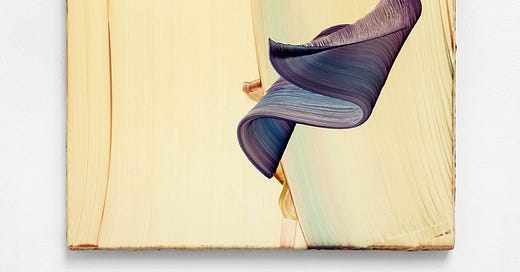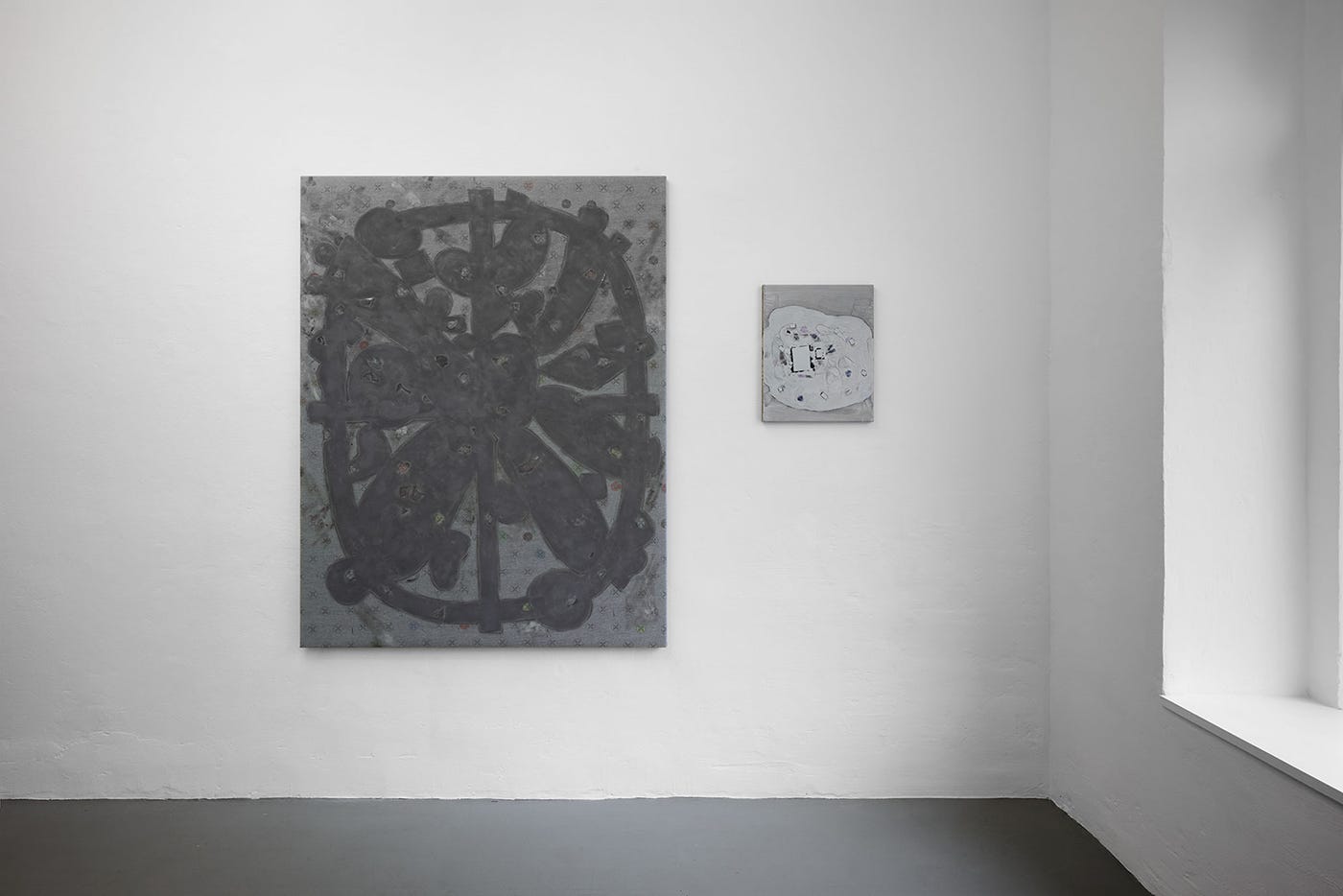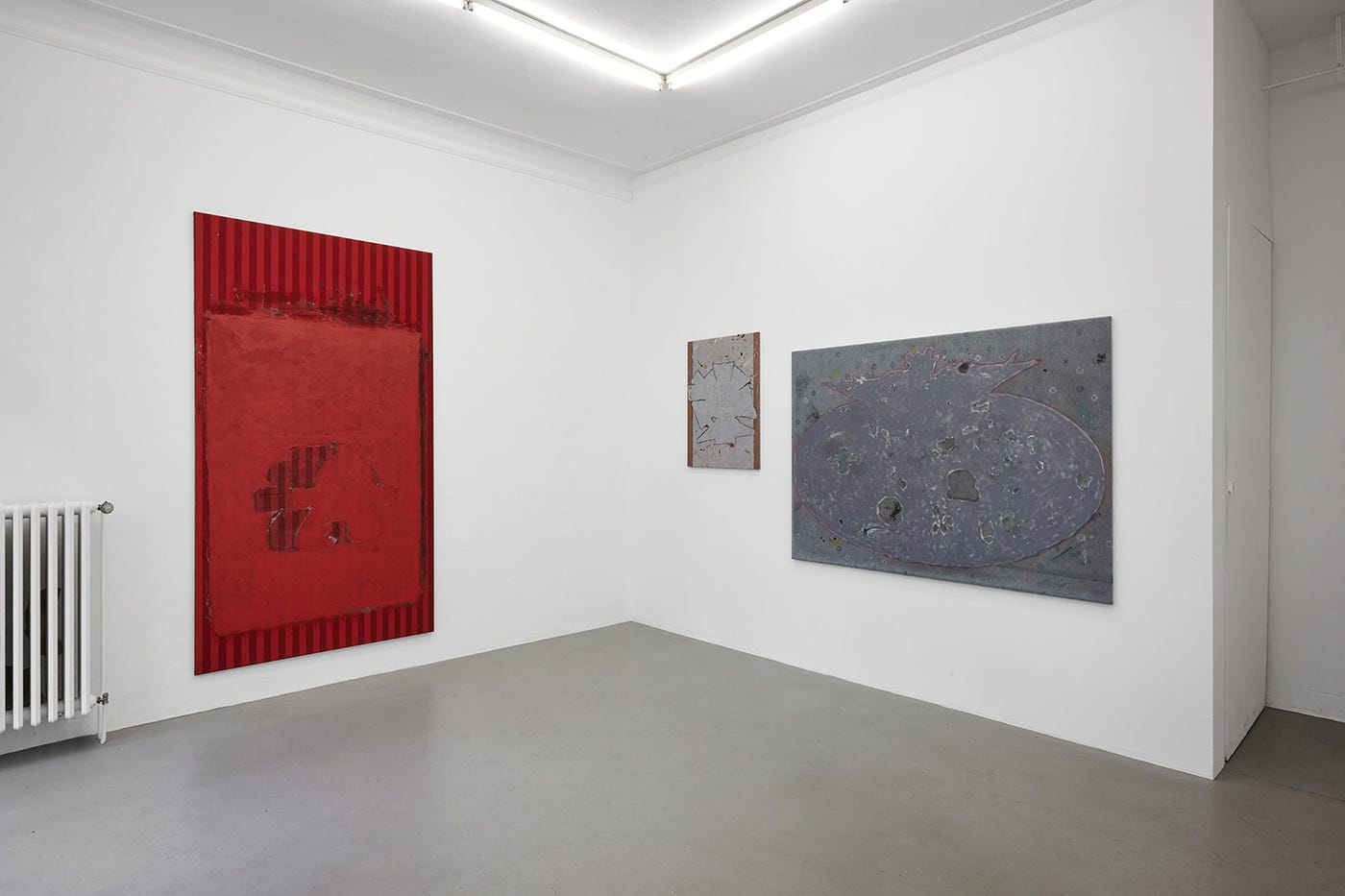Scuffed Fabrics, Sculpted Brushstrokes & TLTR Concepts: Three Shows in Cologne's Belgian Quarter
Let's see what's going on at Khoshbakht, DREI, and Clages right now.
Mitchell Kehe: Sourdough
Mitchell (Millenial, American) brings up yucky feelings. For his mostly generously sized paintings, he doesn’t use ordinary linen. Instead, he opts for used fabric. Dirty fabric. Fabric that has been through a lot, probably never got to see the inside of a washing machine and is very close to molding. Yeah, I imagine where that Sourdough is forming.
Mitchell adds acrylic, oil paint, glossy enamel and more artificial material. He paints abstract forms that — if I had paid attention in biology class in highschool — would have reminded me of plant cells. Or microbes. Or bacteria. Pretty much every work is rather gray as if I’m looking at these teeny tiny organisms and cells through a microscope.
Untitled 1 (Sourdough) (2024) is different, though. Red striped fabric, in the middle, a shape with protrusions and bulges. The fabric underneath the layer of paint peeks out like the shadow of a rising bread loaf baking in the oven. It could also be a slice of toast as you have them in the UK or US (blank, way too fluffy, and sugary). I might even say that the shape remotely resembles the gingerbread man being interrogated about the muffin man.
For Untitled 7 (Sourdough) (2024), Mitchell glued pictures on the thick gooey layer of silvery enamel that looks like a mother-of-pearl plate that was accidently put into a dishwasher. He hid the faces on the pics, sticking paper ontop. That’s where I don’t catch up anymore to the Sourdough theme. Its hard to think of anything that’s not gross in between those stains, eventhough one can’t tell for sure what the real, “authentic” dirt of the textiles is and what Mitchell added. In any way, this rugged, dark chaotic vibe is kinda giving Jean Dubuffet (1901-1985, French).
Khoshbakht, until April 13, 2024. Jülicher Strasse 24a, 50674 Cologne
Markus Saile: Everything Folds
I’m mad. Not at Markus (Millenial, German). Mad at myself because there’s an artist using a similar technique and I just can’t remember who it was. Anyway, if I come up with it, I’ll let you know.
Markus’ paintings are abstract. Set against a light background, he layers wide waves of paint he achieves using a broad brush. These waves are physically flat. They don’t protrude from the canvas. The most 3D you get is the layers of paint dripping from the sides like cake frosting or candle wax. But the brushstrokes themselves stay flat. Markus sculpts them visually, through motion. Turning the brush from one direction into another, abruptly stopping, picking up again and repeating, the paint layers really seem to fold through the color changes.
A small untitled 3:4 format has the outlines of the olive green and turquoise brushstrokes defined so clearly that it almost becomes cartoonish. The works with lighter color palettes make me think of the soap in a carwash distributed rhythmically by the windshield wipers.
Another artist I’ve been thinking of is Robert Janitz (German, Babyboomer) who similarly applies broad brushstrokes in large gestures. But while Robert lets the paint take up space and collect at certain points, Markus insists on flatness. In this show, he also goes for unusually tight formats that make it difficult to imagine how he could even manouvre a brush on such thin slots.
DREI, until May 4, 2024. Jülicher Strasse 14, 50674 Cologne
Frances Scholz: Wave Painting Particle Sculpture
First things first, the exhibition text gave me a headache. Apparently, I need a degree in quantum physics and environmental science to grasp the content of the show. And as I said earlier, I didn’t pay much attention in science classes. The bottom line of the show is Frances (Baby Boomer, German-American) bringing together technology and nature through art. So far, so good.
Upstairs, anoraks with military camouflage prints are draped in corners. The pattern mimicking nature is a masquerade, blending in while actually hiding a parasite in the environment. Frances printed her mannequin-resembling “Earth People” on some anoraks. It might allude to the Hebrew word “ben adam”, literally translated as “son of human” or “son of earth”. So, basically, humans, but more cryptic. In between the fabric folds, tablets screen AI rendered videos of growing tree roots that Frances made in the forests of Connecticut. Apart from making the video more three-dimensional, I can’t really tell what the use of AI adds to the concept. Countering nature with artificiality? My timbers are shivered.
A 2,4 x 1,5 m long white cloth hangs in the gallery space downstairs. Three overlapping sections make up the work. One day, Frances walked by a Tiffany’s storefront in NYC and saw glass bones. It must have been something valuable. She took a picture and enlarged it on the fabric. A bit lower, she added a black and white picture from a newspaper article on the liberation of a torture chamber in ‘90s Kosovo (oddly specific but ok). A smaller version of the glass bones takes up the floor space right infront of an armed soldier guarding the room. Finally, she fills the third section with a print of a Roman mosaic. There’s clams, chicken bones, plants, and fruits. The mosaic captures the ancient tradition of throwing food on the floor to demonstrate wealth and as an offering for the dead. The glass bones appear three times in total, the last time as a small print in the lower right corner. The title of the work, Dir sind die Knochen nicht gebrochen (2024) alludes to the prophecy of Christ not getting his bones broken on the cross. I’m out of breath trying to connect all these dots: Jewelry, war crimes, death, ancient rituals, theology, artificiality and nature… Girl, pick one thing. Two or three max.
Glass returns in Frances’ work Earth Wall (Silver Arms meets Skeleton) (2023). She rendered an uprooted tree in dichroitic glass she created in collaboration with a specialized studio. The three layers are not pigmented, and yet the color changes depending on the perspective. The bark texture is beautifully visibe on the inside. Well, looks like we have a connection back to the glass bones earlier. And glass equals molten sand which is basically finely grated stone…which doesn’t really circle back to the general forest/tree theme.
The paintings didn’t do it for me. A few dry brushstrokes take up the center of each otherwise blank canvas. Frances projects fragments of one painting on another and repaints that detail in a different scale. That’s how patterns repeat. Individually, they are intriguing. But in the context of this show, they feel like a random appendix. Not according to the text, as the exhibition is “calling on the wave-particle duality of quantum mechanics which plant life depends upon.” A complicated concept is not necessarily a helpful one. Geez Louise, I need to go touch some grass.
Clages, until May 11, 2024. Brüsseler Strasse 5, 50674 Cologne
Check out my past reviews of Cologne galleries & subscribe to my newsletter to always stay up-to-date on shows here.
Happy Easter Holidays to everybody! As you’re receiving this one, I just landed in Venice. New content on art shows in La Serenissima is coming! Like, comment, and share if you don’t mind :)
See you soon!!!
Jennifer
The Gen Z Art Critic










